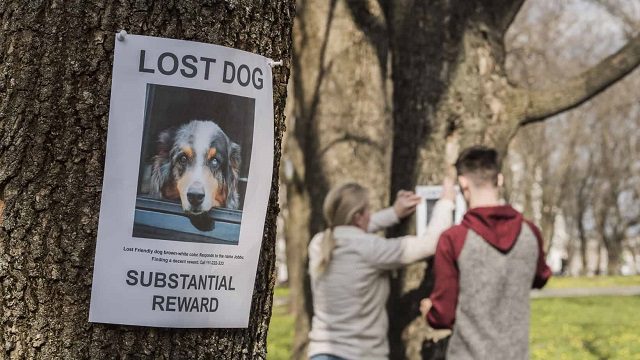How to Find a Lost Dog: 10 Tips to Bring Your Missing Dog Fast
If you have lost your dog, it is important to take immediate action to try to find them. First, contact local animal shelters and veterinarians to report your dog missing and to see if anyone has brought in a dog matching your dog’s description. You can also create and distribute flyers in your neighborhood and surrounding areas with a picture of your dog and your contact information.
Utilize social media platforms to spread the word about your missing dog and place an ad in your local newspaper or on online classifieds websites. You should also check local parks, woods, and other areas where your dog may have wandered and ask your neighbors to check their yards and sheds. If your dog has a collar with a GPS tracker, use tracking apps like “Find My Pet GPS” or “Tile” to locate them.
If you are unable to find your dog, consider hiring a professional pet detective or a search-and-rescue team to help find your missing dog. It is important to not give up hope and keep searching until you are reunited with your furry friend.
Here are some tips to get your lost dog back faster to give you a better idea.
1. Search neighborhoods and parks for a lost dog
If you’ve lost your dog, it’s important to start searching for them as soon as possible. Begin by searching your immediate neighborhood, including nearby parks and wooded areas, as well as any other areas where your dog may have been known to wander.
Check with your neighbors, and post flyers and announcements in the area with a recent photo of your dog and your contact information. Additionally, you can contact your local animal control or shelter to report your missing dog and check if they have any information on its whereabouts.
2. Put up flyers with a recent photo of your dog
If you’ve lost your dog and want to try to find it, one thing you can create a lost dog flyer with a recent photo of your dog and post them around your neighborhood, local parks, and nearby areas where your dog may have been.
Here are some creative lost dog flyer examples to give a better idea.
The flyer should include a clear, recent photo of your dog, its name, your contact information, and any other relevant details such as any distinctive markings or behavior. Additionally, it’s a good idea to check with local animal shelters and vet clinics in case someone has found your dog and taken it there.
3. Inform local shelters and animal control of the missing dog.
It’s important to notify local animal shelters and animal control officers that your dog is missing as soon as possible. They can keep an eye out for your dog and may have information about any stray dogs that have been found in the area. You can also post on social media and local lost and found pet groups about your missing dog, and ask friends and family to share the post to increase visibility.
When you call or visit the animal shelters, it’s a good idea to have a recent photo of your dog, its name, and any unique characteristics, such as a collar or microchip, to help them identify it if they come across it.
4. Utilize social media to share information about your lost dog
Create a post on your personal social media profiles (Facebook, Twitter, Instagram) with a photo of your dog and a brief description of when and where they were last seen. join local community groups on social media, such as neighborhood groups on Facebook, and post information about your lost dog there.
Utilize social media pages dedicated to lost pets in your area, such as “Lost Dogs of [City Name]” on Facebook. Share your post on social media pages of local animal shelters, veterinarians, and pet stores in your area. tag friends and family members in your post and ask them to share it with their networks.
5. Offer a reward for info on returning lost dog safely
Offering a reward for information leading to the safe return of your dog can be an effective way to encourage people to come forward with information. Here are a few things to keep in mind when offering a reward. Be specific about what the reward is, and make sure it is something that will be appealing to people who may have seen your dog.
Clearly state the terms of the reward, such as when and how it will be paid out. Consider offering the reward through a third-party, such as a local animal shelter or veterinarian, to ensure the safety and confidentiality of the person providing the information. It’s also a good idea to consult with local authorities before offering a reward as there may be regulations or laws that you must follow.
6. Reach out to pet recovery/search groups for help finding the missing dog.
Contacting local pet recovery or search and rescue groups can be a good idea when searching for a lost pet. These groups often have experience and resources for finding lost animals and may be able to provide assistance and support during the search.
Additionally, you can also contact your local animal shelters or humane societies and post about your missing pet on social media and local online classifieds or community groups.
7. Remember dog may be disoriented, approach calmly and quietly.
It’s important to remember that a lost dog may be frightened and disoriented, and may not respond to familiar commands or even recognize their own name. It’s best to approach them calmly and quietly, and to call out their name in a soothing tone.
If possible, try to lure them with treats or toys they are familiar with or bring an article of your clothing with your scent on it to help them recognize you. Additionally, make sure to check with local animal shelters and post on social media to let others know your dog is missing and to be on the lookout.
8. Use a flashlight to search for the missing dog at night/early morning.
Using a flashlight to search for your dog at night or early in the morning can be helpful. A flashlight can help you see in the dark and make it easier for you to spot your dog from a distance. Additionally, the light from the flashlight can also help your dog spot you and may make them more likely to come to you.
When searching for your dog, it’s also a good idea to take someone with you and to search in areas where your dog is familiar such as your neighborhood, parks, or other places they like to go.
9. Search local classifieds and social media groups for lost dog reports.
Checking for lost dog reports on online classifieds and social media groups in your area is a good idea. Many people who find lost dogs will post about them on these platforms in order to try and find the dog’s owners. Some popular online classifieds and social media groups to check include local Facebook groups, Nextdoor, Craigslist, and Lost & Found Pets groups.
Additionally, you should also check with local animal shelters and veterinary clinics in your area, as they may have taken in a lost dog that matches your dog’s description. It’s also a good idea to post about your lost dog on these platforms, with a detailed description, photos, and the location where your dog was last seen.
10. Place a familiar item outside to aid in your dog’s return home.
Leaving a familiar item, such as a blanket or toy, outside can be helpful in helping your dog find their way back home. The familiar scent of an item that your dog is used to can help them identify your home and may make them more likely to return. Additionally, it’s a good idea to leave the item in a visible location, such as near your front door or in your yard, so that your dog can easily spot it.
It’s important to remember to keep your dog’s safety in mind. Leave the familiar items in a secure location where they won’t be disturbed or stolen, and also make sure to keep your house, yard, and surrounding areas safe and secure for your dog when they return.
Bottom Line
In summary, when a pet goes missing it is essential to take immediate action, search the immediate area, post on online classifieds and social media groups, contact local animal shelters and veterinary clinics, and make sure your pet’s identification tags are up to date. Additionally, consider putting up flyers in your neighborhood, and surrounding areas, and don’t limit your search to just your immediate area. Microchipping your pet can also be a helpful tool in reuniting lost pets with their owners. Taking these steps can increase the chances of finding your missing pet and bringing them home safely.
PhotoADKing provides an extensive range of flyer templates that are designed for every need or, you can use your imagination to design from scratch. PhotoADKing provides a large image library of over 1 million icons, backgrounds, and photos, plus hundreds of free fonts, and got all the ingredients you need to get the desired look for your lost dog flyers templates.






